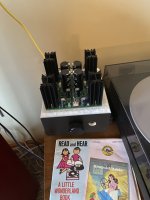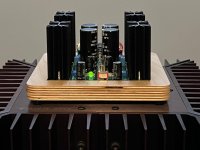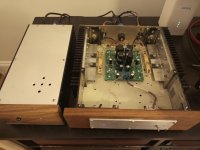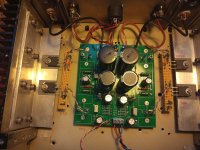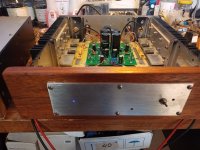Here's mine. I couldn't get the push button switch to work, so it left a hole in the front until I get around to swapping a few things around. I 3D printed the transition piece. I like running it straight from my phono preamp, so I added volume control. It gets loud enough to make conversations challenging but doesn't rock the house. Perfect for the main living area.
Attachments
Found it! It was quite a bit earlier than I had guessed.

Eric made one that was very similar… on post #253
I like the solid wood, looks fantastic!

I like the solid wood, looks fantastic!
I liked your original idea of using a picture frame way back when. Those of us who lack woodworking skills would have benefited.
After losing another IRF9520 ( I guess my fault as I left the amp idling fully switched on) I decided to overhaul the whole thing and fit the output FETs on a "proper" sink.
And as I run out of IRF9520 decided to use my little stash of LatFets, k1058 & j162.
One thing leads to another, redesigned the whole PSU and amp enclosures using sinks from some old satellite receivers, also fitted 100R gate resistors and fired it up.
Well, the amp biased up just fine, Vb and Vo adjusted easily and stayed stable for a long time, I guess due to the thermal mass of the heatsink.
Bias around 0.7A(Vb 0.475V) and steady.
Sinks get hot but not uncomfortably hot. I guess with bigger sinks one can increase Vsupply to 32 - 36V and also ramp up the bias to at least 1A. That IMHO will be a killer amp.
Played some favorite stuff for a good 2 hours, great sound, but early days for a definite conclusion.
All credit goes to Mr. Pass for a versatile, flexible design.
Looking forward to F5m, the new/old cousin of ACA-mini.
And as I run out of IRF9520 decided to use my little stash of LatFets, k1058 & j162.
One thing leads to another, redesigned the whole PSU and amp enclosures using sinks from some old satellite receivers, also fitted 100R gate resistors and fired it up.
Well, the amp biased up just fine, Vb and Vo adjusted easily and stayed stable for a long time, I guess due to the thermal mass of the heatsink.
Bias around 0.7A(Vb 0.475V) and steady.
Sinks get hot but not uncomfortably hot. I guess with bigger sinks one can increase Vsupply to 32 - 36V and also ramp up the bias to at least 1A. That IMHO will be a killer amp.
Played some favorite stuff for a good 2 hours, great sound, but early days for a definite conclusion.
All credit goes to Mr. Pass for a versatile, flexible design.
Looking forward to F5m, the new/old cousin of ACA-mini.
Attachments
After losing another IRF9520 ( I guess my fault as I left the amp idling fully switched on) I decided to overhaul the whole thing ....
Why would leaving the ACA Mini fully on destroy an IRF9520? I leave mine on all day, biased at 370 mV and idling about half the time, though I turn it off overnight. The heat sinks get too hot to touch for more than a few seconds. No problems so far.
No idea, could be bad luck. Only the left channel was affected and only the P fet.
@Stanislav: One thing I noticed is that, when the MOSFET bolts have been tightened "just right," they get loose after the lock washers have adjusted to being compressed, so they need to be retightened after a day. On one of my Minis, the lefthand side heat sinks weren't very hot before this retightening. Once I retightened, they warmed up the same amount as the righthand side.
I guess it's possible for MOSFETs to fail if they aren't properly attached to the heat sinks.
I am brand new to this technology. I asked @Nelson Pass about biasing, heat sink temperature, and the possibility of burning up MOSFETs, and he kindly replied that: the ACA Mini likes to be biased between 350 and 390 mV; if the heat sinks get too hot to touch for more than a few seconds, "that's about right"; and under these conditions the MOSFETs ought to last "longer than your grandchildren" [I have none, though].
So I set the bias to 370 mV at 70 degrees F ambient temperature and run the Mini all day without problems or worries. I have a little fan to aim at the Mini on days when the indoor temperature is higher than usual, but so far I haven't used it.
I guess it's possible for MOSFETs to fail if they aren't properly attached to the heat sinks.
I am brand new to this technology. I asked @Nelson Pass about biasing, heat sink temperature, and the possibility of burning up MOSFETs, and he kindly replied that: the ACA Mini likes to be biased between 350 and 390 mV; if the heat sinks get too hot to touch for more than a few seconds, "that's about right"; and under these conditions the MOSFETs ought to last "longer than your grandchildren" [I have none, though].
So I set the bias to 370 mV at 70 degrees F ambient temperature and run the Mini all day without problems or worries. I have a little fan to aim at the Mini on days when the indoor temperature is higher than usual, but so far I haven't used it.
Thanks for the insight. It's quite possible that that was also my case.
I like the new sink arrangement though, it reduces the temperature and bias fluctuations and lets me crank up the bias significantly.
OTH it complicates the build as it need an enclosure and is way more involved.
I'm building another Mini with the original Harris Fets and will build it exactly as this one so can compare the sound.
BTW, I placed shorts across the source resistors of the Latfet Mini, so they are practically not in the circuit anymore. Curious to see what difference will that make.
Cheers.
I like the new sink arrangement though, it reduces the temperature and bias fluctuations and lets me crank up the bias significantly.
OTH it complicates the build as it need an enclosure and is way more involved.
I'm building another Mini with the original Harris Fets and will build it exactly as this one so can compare the sound.
BTW, I placed shorts across the source resistors of the Latfet Mini, so they are practically not in the circuit anymore. Curious to see what difference will that make.
Cheers.
It is not entirely unknown for a transistor to croak without a good excuse.


Suggestions on wire to run from the RCA jacks, panel mount, to the PCB? CAT5? Shielded? I have some Audioquest McKenzie balanced cable kicking around.
Thx, and avoids the quagmire I was just reading about, gnd the shield or not, gnd. 1 end, 2 end!!! It always appealed to my "Logical Side", gnd shield to source, but so many expert opinions! Yikes!CAT6 twisted pair
Uses Teflon (PTFE) insulation which is much better to work with, doesn't melt at soldering temperatures.
Just got my 2nd Mini going, and perhaps I heated the pots a bit much, but this one is much more twitchy adjusting VO/VB. Seems to be dialed in but the other 1 was pretty smooth as I rotated the pot, this one tends to have some flat(?) spots. I'll keep an eye to make sure that it stays dialed in.
Right now listening to some Hendrix, not the best music to evaluate with LOL!
Right now listening to some Hendrix, not the best music to evaluate with LOL!
Could the Mini be configured with lower bias on the output transistors and be used more like a front end? I see mention of similarities between the F5 and the Mini, and what with Patrick's project with F5pre into M2OPS.....got me thinking.
I think you can definitely do that, just look at BA-3:
https://diyaudiostore.com/collections/pre-amplifier/products/burning-amplifier-gain-stage-for-ba-3
https://cdn.shopify.com/s/files/1/1006/5046/files/P-BAGSN-1V20-schematic.pdf
https://www.diyaudio.com/community/threads/the-ba-3-as-preamp-build-guide.258022/#post3968063
Of course it will need a few changes, like values of source resistors, maybe the pots.
You can use the Harris Fets, but think about fitting IRF610 & 9610 instead.
That will be a very interesting deviation from the Mini concept.
https://diyaudiostore.com/collections/pre-amplifier/products/burning-amplifier-gain-stage-for-ba-3
https://cdn.shopify.com/s/files/1/1006/5046/files/P-BAGSN-1V20-schematic.pdf
https://www.diyaudio.com/community/threads/the-ba-3-as-preamp-build-guide.258022/#post3968063
Of course it will need a few changes, like values of source resistors, maybe the pots.
You can use the Harris Fets, but think about fitting IRF610 & 9610 instead.
That will be a very interesting deviation from the Mini concept.
- Home
- Amplifiers
- Pass Labs
- DIY ACA mini

